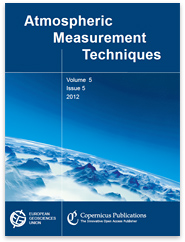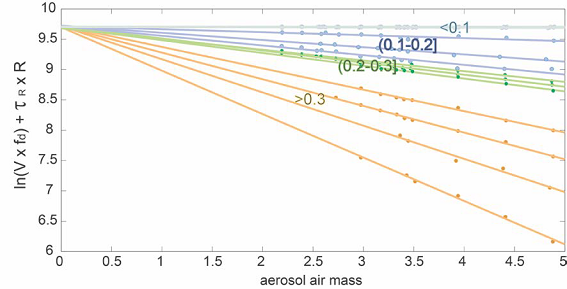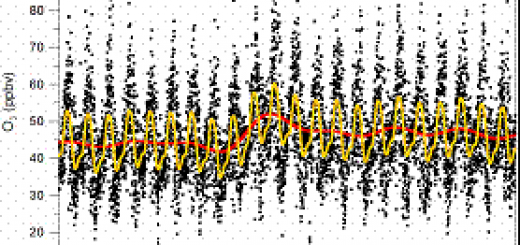Recovering Long-term Aerosol Optical Depth Series (1976-2012) from an Astronomical Potassium-based Resonance Scattering Spectrometer

Last April was published a long term series of aerosol optical depth (AOD) at Izaña (Tenerife, Spain) retrieved using the Mark-I potassium-based resonant scattering spectrometer, in the journal Atmospheric Measurement Techniques Discussion (AMTD). This work has been possible thanks to the collaboration between the Izaña Atmospheric Research Center (IARC-AEMET) and the Instituto de Astrofísica de Canarias (IAC). This study has implied the recovering of a long term series of AOD (37 years) for Izaña. It can be considered as one of the longest existing AOD records in the world, with aerosol information from 1976 onwards.
This study has been extended for its publication in the journal Atmospheric Measurement Techniques (AMT). In addition to the good agreement found in the previous version regarding the comparative analysis between Mark-I and collocated quasi-simultaneous AOD from Cimel AErosol RObotic NETwork (AERONET) and Precision Filter Radiometer (PFR) instruments running at Izaña since as early as 2001, in this new publication the suitability of performing Langley calibration analysis under a priori non-ideal conditions (AOD≤0.3) has been assessed and proven. This is an outstanding result since it tells us that we can obtain reliable V0 (instrumental extraterrestrial constant for each wavelength) in long periods of relatively high AOD affected by mineral dust conditions or persistent volcanic aerosols, like the conditions observed after Mt. Pinatubo eruption (Philippines, June 1991). In Figure 1, 15 different Langley plots extracted from Cimel-AERONET data at Izaña are displayed. They are grouped into four AOD intervals, ranging from AOD > 0.3 (high turbidity, in orange) to AOD < 0.1 (low turbidity, in light blue). It clearly shows a nearly constant extrapolation to zero air mass regardless of the aerosol loads in the atmosphere, with relative differences up to 0.31%. These differences yield to AOD errors ranging from 0.001 to 0.003, lower than the precision expected for Cimel AERONET instrument. These results are a consequence of the special characteristics of Izaña, and they cannot be extrapolated to other sites in the world. In Izaña we can find two opposite atmospheric regimes: clean background conditions and dusty events. The first one implies quite stable and pristine skies suitable to perform accurate Langley calibrations following the standard Langley plot procedure. In this work the authors have shown that the second regime also implies very stable AOD and Angstrom Exponent (AE) conditions to perform Langley calibration, since practically the entire aerosol content consists of very coarse mineral dust particles, with a nearly flat spectral response of AOD as a result of the specific characteristics (vertical mixing and stability) of the Saharan Air Layer (SAL).

Fig. 1: Langley-plot performed at Izaña for different aerosol content intervals, from AOD>0.3 in orange to AOD<0.1 in light blue.
Finally, the 37-yr AOD series determined with Mark-I as well as the long term monthly variation of the homogenized data set are shown in Fig. 2, in which the impact of volcanic events like the El Chichón eruption in 1982 and the Mt. Pinatubo eruption in 1991 are clearly detected. The AOD anomaly observed after El Chichón eruption in 1982 was 0.016, while the anomalies were significantly lower (0.005) in 1983. In the case of Mt. Pinatubo, the anomalies observed after the eruption were more important and persistent than for El Chichón eruption, recording a peak impact in 1992 with an AOD anomaly of 0.020. The effects of Mt. Pinatubo eruption in AOD were not significantly reduced until early 1993.

Fig. 2: Long-term AOD (at 769.9 nm) variation at Izaña extracted from Mark-I scattered data (from 1976 to 1983 as well as from 2003 to 2012) and transmitted data (from 1984 to 2002). Monthly mean of the homogenized AOD series is displayed through the violet line. No available data from 1978 to 1980.
Further details about this study can be found in the on-line paper:
Barreto, A., Cuevas, E., Pallé, P., Romero, P. M., Guirados, C., Wehrli, C. and Almasa, F.: Recovering Long-term Aerosol Optical Depth Series (1976–2012) from an Astronomical Potassium-based Resonance Scattering Spectrometer, Atmospheric Measurement Techniques (http://www.atmos-meas-tech.net/7/4103/2014/amt-7-4103-2014.html).






